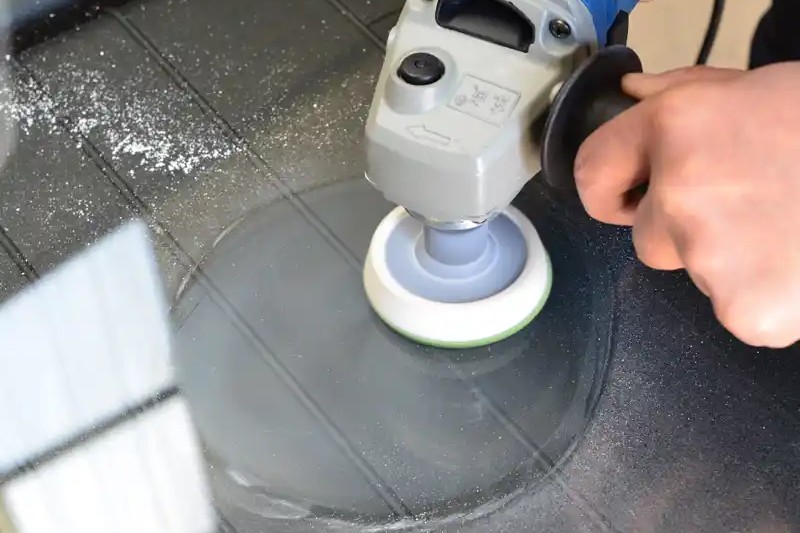Diamond grinding wheels are essential tools in the glass processing industry, known for their high precision and smoothness. However, the finish of ground glass is sometimes substandard. This article will analyze the main reasons for insufficient finish when using diamond grinding wheels, and provide practical solutions to these problems.
Problem Analysis
1. Improper selection of diamond grinding wheels for glass
Choosing the right diamond grinding wheel is crucial to achieving the desired surface effect. If the wrong type of grinding wheel is selected, the grinding effect will be seriously affected.
Larger grit size: If the grinding wheel has a larger grit size, the glass will have a rougher finish. This is because the larger the grit, the faster it removes material, resulting in a less refined finish.
Smaller grain size: Conversely, if the grinding wheel has a smaller grain size, it may take longer to achieve a smooth surface. While finer grains can produce a better finish, they may require more time and effort to grind effectively.
2. Improper use of grinding wheel
The way the grinding wheel is used can also affect the finish of the glass. Several factors can lead to unsatisfactory results:
Spinning too fast: If the grinding wheel spins too fast, it will generate too much heat, causing thermal damage to the glass and a poor finish.
Feed rate too fast: Feeding too fast can cause the grinding wheel to not be able to effectively smooth the surface, resulting in an uneven surface.
3. Improper maintenance of grinding wheel
Maintenance of diamond grinding wheels is essential to maintain their performance and ensure a smooth finish. Neglecting maintenance can lead to several problems:
Glass buildup: If the grinding wheel is not properly maintained, glass will accumulate on its surface. This buildup will hinder the grinding process, reduce the efficiency of the grinding wheel, and cause a rough surface.
Cutting edge dulling: Over time, diamond particles become dull, affecting grinding efficiency and the quality of the finished product.
Solution
1. Choice of diamond grinding wheels for glass
The first step to ensuring a smooth surface is to select the appropriate grinding wheel. The characteristics of the glass being ground, such as thickness, surface finish, and hardness, play a vital role in determining the appropriate grinding wheel.
Grit size: Choose a grinding wheel with the appropriate grit size. To achieve a finer finish, a wheel with smaller diamond grit is recommended, while a coarser wheel may be suitable for initial shaping or rough grinding.
Hardness: The hardness of the grinding wheel should match the hardness of the glass. A softer wheel may wear too quickly when grinding harder glass, while a harder wheel may not be able to effectively grind softer glass.
By carefully selecting a grinding wheel that meets the specific requirements of glass, users can more effectively achieve the desired grinding results.
2. Conditions for use of grinding wheels
The condition of the grinding wheel has a significant impact on the quality of the machining process. Here are some key considerations:
Grinding wheel speed: Mastering the proper speed of the grinding wheel is critical. If the speed is too high, excessive heat will be generated, causing thermal damage to the glass surface. Reducing the rotation speed can help prevent overheating and improve the finish.
Feed rate: Again, the feed rate should be adjusted based on the grinding task. Feeding too fast will prevent the grinding wheel from grinding the surface effectively. Finding the right balance between speed and feed rate is critical to achieving the best results.
By monitoring and adjusting these parameters, users can ensure that the grinding wheel is operating under ideal conditions, resulting in a smoother surface.
3. Grinding wheel maintenance
Proper maintenance of your grinding wheel is essential to maintaining its performance and ensuring a high-quality finish. Here are some maintenance tips:
Cleaning: After each use, it is very important to clean the grinding wheel to remove any glass slag or debris that may have accumulated. Use a clean cloth dampened with mild detergent to wipe the grinding wheel, making sure no detergent comes into contact with the wheel bearings.
Inspection: Regularly inspect the grinding wheel for signs of wear or damage. If the wheel appears dull or uneven, it may need to be dressed or replaced to maintain effective grinding performance.
Storage: Store grinding wheels in a clean, dry environment to prevent contamination and damage. Proper storage can extend the life of the grinding wheel and maintain its effectiveness.
By implementing a routine maintenance schedule, users can keep their grinding wheels in optimal condition, which is essential to achieving a smooth surface on the glass.
In Conclusion
Problems with insufficient finish when grinding glass with diamond wheels can often be traced back to issues related to wheel selection, operating conditions, and maintenance. By understanding the importance of selecting the right diamond grinding wheels for glass, mastering proper operating conditions, and properly maintaining the wheel, users can effectively address these challenges. Attention to detail and adherence to best practices will result in better grinding results and a smoother glass product finish.
Post time: Nov-15-2024

